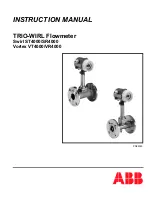
PN25080
Swirlmeter
(TRIO-WIRL S) 2 - 1
TRIO-WIRL INSTRUCTION MANUAL
CHAPTER 2 Swirlmeter (TRIO-WIRL S)
2.1 General
The volumetric flowrate of steam, gases and liquids
can be measured over wide flow ranges independent
of the fluid properties with this newest member to the
Swirlmeter line.
Special features of this Swirlmeter are:
*
Accuracy:
≤
±0.5% of rate
*
Minimal piping
*
Wide flow range
*
Suitable for liquids with viscosities up to 30 cst
*
Selectable operating modes for volume and mass
rates
2.2 Measurement Principle
The Swirlmeter body contains stationary swirler blades
at the meter inlet. The design of these blades forces
the axial flow of the fluid into a rotational movement.
Due to this "swirling" of the fluid, a vortex is generated
at the center of the rotation and forced by a backflow
into a secondary rotation whose frequency is propor-
tional to the flow rate. The generation of the vortex is
shown pictorially in Figures
. The generated
frequency is linear over a wide flow range due to the
optimized internal geometry of the instrument and is
measured using a piezoelectric sensor. The sensor's
frequency signal is converted by the Converter elec-
tronics into a 4 - 20mA DC output current
2.2.1 Liquid Flow Back Pressure
In order to prevent cavitation in the meter it is neces-
sary to maintain a minimum back pressure in the sys-
tem. The required back pressure is determined using
the following formula:
P
b
> 1.3P
v
+ 2.6
∆
P
Where:
P
b
= minimum required back pressure (psia)
P
v
= vapor pressure of the fluid at specified condi tions (psia)
∆
P = pressure drop (psia)
FIGURE 2-1 MEASUREMENT PRINCIPLE,
TRIO-WIRL S
Piezo
Sensor
Outlet Guide
Body
Inlet Guide
Body
Housing
Stagnation Point
FIGURE 2-2 OPERATING PRINCIPLE, TRIO-WIRL S
Housing
Inlet Guide Body
Piezo Sensor
Flow Direction
V
A
= 0
V
A
= 0
Vortex Core
p2
V
T1
V
T2
p1
v
V
A
= Axial velocity component
V
T
= Tangential velocity component
(V
T1
> V
T2
)
P = static pressure
(p1 < p2)
V
A
V
A
Stagnation
Point



























